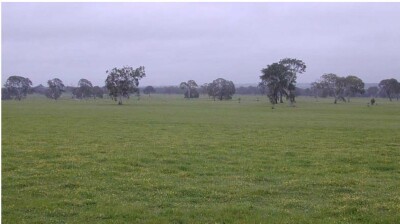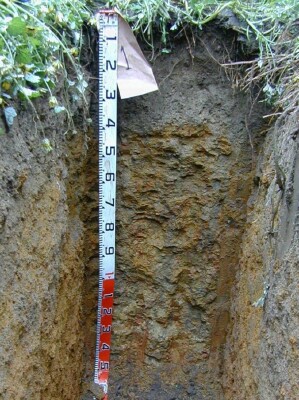ELL98 (Plot 1)
| Site: ELL98 (Plot 1) | Land Unit: Marl |
 |
General Land Unit Description:
Two year old Eucalyptus globulus plantation on ex-agricultural land |
Site Description:
| Slope: 1o | Geology: Tertiary marl |
| Landform pattern: Gently undulating plain | Internal drainage: Imperfectly drained |
Soil Profile Morphology
| A1 | 0-20 cm | Very dark greyish brown (10YR3/2) fine sandy loam; weak polyhedral structure (10-20 mm); very weak consistence when moist; few fine macropores; areal porosity 0.01%; many medium roots; clear and smooth transition to: |  |
| A21 | 20-30 cm | Brown (10YR5/3) fine sandy loam; weak polyhedral structure (10-20 mm); weak consistence when moist; common fine macropores; areal porosity 1.5%; common fine roots; abrupt and smooth transition to: | |
| A22 | 30-45 cm | Brown (10YR5/3) fine sandy loam; weak polyhedral structure (10-20 mm); weak consistence when moist; common very fine roots; abrupt and wavy transition to: | |
| Subsoil | |||
| B21 | 45-70 cm | Brown (10YR5/3) with common medium distinct reddish yellow (5YR7/8) and red (2.5YR4/8) mottles, light medium clay; strong subangular blocky structure (20-50 mm) parting to strong polyhedral structure (5-10 mm); weak consistence when moderately moist; many coarse ferruginous nodules; few fine macropores; areal porosity 0.001%; few very fine roots; diffuse and smooth transition to: | |
| B22 | 70-110 cm | Brown (10YR5/3) with many medium distinct reddish yellow (5YR7/8) and red (2.5YR4/8) mottles, medium clay; strong polyhedral structure (20-50 mm) parting to strong polyhedral structure (5-10 mm); firm consistence when moderately moist; few fine macropores; areal porosity 0.01%; few very fine roots; diffuse and smooth transition to: | |
| B23 | 110-150 | Yellowish brown (10YR5/6) with many medium prominent red (2.5YR4/6) mottles, light medium clay; strong polyhedral structure (20-50 mm) parting to strong polyhedral structure (5-10 mm); firm consistence when moderately moist; few fine macropores; areal porosity 0.01%; no roots observed. | |
| 150-400 | Mottled red and grey clays, decomposing basalt (not basalt segregations), a little compacted, no root impeding layer | ||
Notes: wormcasts and root channels observed to 150 cm, Mn staining observed on ped faces and increased with depth from 45 cm, slickensides present between 110-150 cm.
Sampled by: Ian Sargeant and Paul Feikema (24 October 2000)


